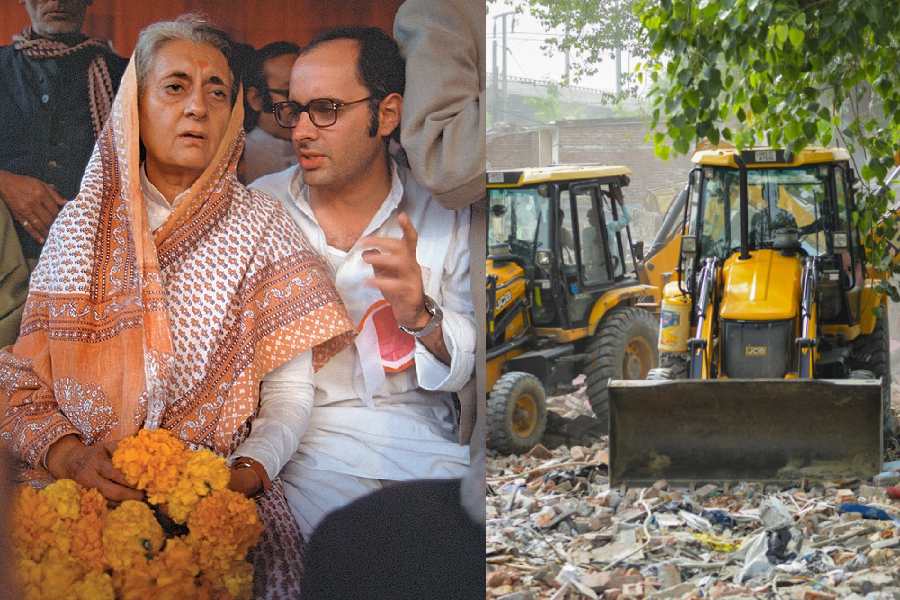IN SEARCH OF THE MAHABHARATA: NOTES OF TRAVELS IN INDIA WITH PETER BROOK,1982-85
By JeanClaude CarriËre,
Macmillan, Rs 198
Standing on the rue St André des Arts in Paris in 1974, at three o.clock in the morning, Luis Buñuel's legendary scriptwriter and a great European theatre director made a .mutual commitment.. JeanClaude Carrière and Peter Brook had just emerged from a long and enchanting story telling session. The teller was the distinguished French Sanskritist, Philippe Lavastine, and his tales were from The Mahabharata. Brook and Carrière immediately decided to work together in bringing this material to the Western audi ence, feeling rather humbled, at that moment, by the enormity of the task..We.ll stage it when it's ready,.Brook assured his friend, .and it will take as long as it takes..
It took Carrière nine years to turn the epic into a play. Brook's international cast rehearsed it for nine months, and the first French produc tion in 1985 took nine hours to perform, from dawn to dusk. For Brook, Carrière's .gigantic achievement. was capturing the essence of this .poetical history of mankind. in a threepart play. There is, however, nothing gigantic about this slim volume of notes and drawings made during Carrière's travels through India with Brook and his company of actors and designers. Beautifully translated by Aruna Vasudeva, it is full of a lightness and immediacy, refreshingly unafraid of lapsing into Orientalism, yet imbued with a sense of the difficulty and seriousness of the endeavour.
The point of these travels was, quite simply, .to see and to hear. a country in relation to .its poem.. Having lived with the text of The Mahab harata for eight years, Carrière is unabashed about approaching .a subcontinent identified by a book.. His intentions are exhaustive, like the .extreme ambition. of the epic itself.He needs to .go everywhere., .gather all the images., to feel the poem's .tenacious presence. within a society where it is .still acted, danced, sung and lived.. This takes him through a .baroque, tumultuous, chaotic. panorama of people, places and art forms. In the precision, sympathy, drollery and wonder that he brings to his sketches, Carrière is both an artist and a picaro, who encounters the .complexities of appearance., the bizarre and the profound, with a puckish inventiveness which Henri Michaux calls .the casualness of a naughty boy.,and which Brook would find indis pensable while turning The Mahabharata into what he calls .impure theatre..
The impure and the inventive, in their most prodigious forms, are essential to the theatre. For Carrière, India generously offers both, in being a place where everything seems to have been foreseen and anticipated, .anything one can do with this or with that.. In the heart of commercial Bombay, he stops in front of a tree: .A rope has been tied around a branch and dan gles down along the trunk. The end of the rope is burning slowly. I am a little surprised at this un known ritual, in the middle of the city. All the more because nobody seems to be looking after it. And then a man arrives, stops, takes a ciga rette out of his pocket and lights it with the end of the smouldering rope. It is, in fact, a public lighter.. Carrière's gaze here is selfconsciously naïve and wondering; but his narrative is pre cise and cinematic, transforming this wayside mystery into a Chaplinesque comedy of human resourcefulness, minimal and stylish in itself as well as in the telling. It is a visual language which the Buñuel of Discrete Charm, the Ray of Aranyer Din Ratri and the Bergman of Smiles of a Summer's Night would have understood perfectly.
The spirit of improvisation is useful for the Mahabharata duo. For instance, Brook picks up from south Indian folk theatre the use of a .sim ple cotton curtain, held by two assistants., and uses this device to stage .the appearance, and then the disappearance, of Krishna.. This .con stant creativity. is noted everywhere in Car rière's notes and sketches, and celebrated by Brook in his introduction to the English transla tion of the play: .If it is a word, a breath, a limb, a sound, a note . or a stone or a colour or a cloth . all its aspects, practical and artistic, have been investigated and linked together..
As artists, both Carrière and Brook are relentlessly pragmatic.They ask of every experi ence in India, .Is it theatre, or not theatre?. A theatrical language has to be forged which will somehow .make of India of the past the world of today.. .But how?. And how not to abandon the action on the way? Is it possible?.
Carrière's every encounter with contempo rary India . the .apparent disorder. and the .clandestine dream of unity. . is informed with this practical anxiety. At Halebid, Bhishma on his bed of sorrows, .and here and there a little sodomy, in between other practices going back to eternity.; the Meenakshi temple, in Madurai, .like a Babylon dreamt up by Cecil B. de Mille and directed by an Indian., with its pilgrims .specially dressed up, like dandified Shivas.; a doddering dancing master who transforms him self magically into a young abhisarika and is im mediately carried away by his pupils; a Kathakali king, .somewhere between a clown and a bishop.; a Krishna from Madras, .very much Fellini.; and .almost all over India the faint, cloying smell of shit.. .How to transpose even a whiff of this,. Carrière wonders, .to the Bouffes du Nord [a Paris theatre]..
The answer to this seems to lie in the univer sality of the human body and its many languages of performance. And this is where the necessary essentialism of the theatre becomes the only working solution to the problem of The Mahab harata's .Indianness.: .What the body can ex press . when one forces it . of another culture and which the mind cannot conceive of !. This leads to two larger questions, which form the core of Carrière's little book. First, does the com plexity of India correspond to the complexity of the greatest poem to have come out of it? Second, and this question also haunts Brook, .What is it that creates the energy, the intensity that one senses at times in the theatre?. How can one find it? How can one hold on to it?.
.Truth in the theatre,. writes Brook in The Empty Space, .is always on the move.. Carrière is driven by this restiveness in India, a compul sive .obligation to play.. Yet, even when the poem has become a code between him and his colleagues, coming constantly .between us and the world., it keeps its secret, .beyond wonder, charm, irritation, repulsion.. At the end of Car rière's play, Yudhishthira is brought by Vyasa and Ganesha to the .last illusion., which is also the silence that comes after the telling of a great story,when .words end, like thought..
 Friday, 06 June 2025
Friday, 06 June 2025









